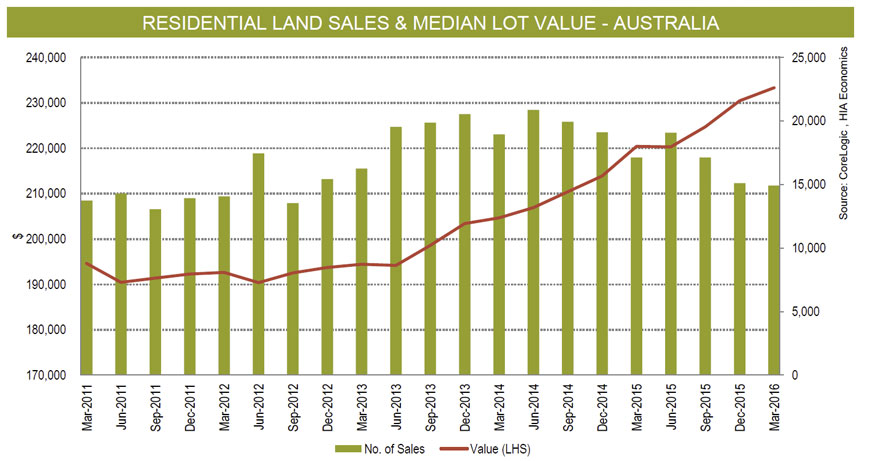The March 2016 edition of the HIA-CoreLogic Residential Land Report has just been released by the Housing Industry Association, and CoreLogic. The report provides detailed results relating to prices and sales activity across Australia’s residential land markets.
During the March 2016 quarter, the pace of growth in national land prices slowed to 1.2 per cent, while turnover in the market fell by 1.3 per cent. The easing of price pressures was helped by a 3.4 per cent increase in land sales in capital city markets, although the number of transactions in regional Australia fell by some 8.1 per cent over the same period.
 During the March 2016 quarter, vacant residential land sales increased most strongly in Perth (+22.3 per cent) followed by Melbourne (+5.2 per cent). However, land market turnover fell in Hobart (-28.4 per cent), Adelaide (-8.3 per cent), Sydney (-5.9 per cent) and Brisbane (-3.4 per cent) over the same period.
During the March 2016 quarter, vacant residential land sales increased most strongly in Perth (+22.3 per cent) followed by Melbourne (+5.2 per cent). However, land market turnover fell in Hobart (-28.4 per cent), Adelaide (-8.3 per cent), Sydney (-5.9 per cent) and Brisbane (-3.4 per cent) over the same period.
“The easing of price growth in the market for residential land is an encouraging sign, particularly given more favourable supply conditions in capital city markets,” HIA Senior Economist, Shane Garrett pointed out.
“However, the value of residential land remains at record highs. This is a key source of affordability difficulties confronted by the many Australian families wishing to purchase their first home,” Shane Garrett cautioned.
“Current arrangements around the funding and delivery of the infrastructure that services new housing are inadequate and preventing the release of more affordable residential land stocks.”.
“As well as hurting ordinary families, the absence of comprehensive reform is paring back Australia’s future growth prospects,” concluded Shane Garrett.
According to CoreLogic research director Tim Lawless, the moderation in the number of vacant land sales has been evident for some time. “National land sales peaked during the June quarter of 2014 and have been trending lower since this time. The quarterly number of vacant land sales hasn’t been this low since the third quarter of 2012,” said Mr Lawless.
“It’s encouraging to see capital city land sales bucking the national trend with an increase of 3.4 per cent over the March 2016 quarter. However, despite the quarterly rise in sales, the number of transactions was still 12.3 per cent lower than in the March quarter of 2015,” added Mr Lawless.
“The fact that vacant land prices are still broadly rising on both a median price and rate per square metre measure, albeit at a reduced pace, at a time when transactions numbers are consistently trending lower sends a clear signal that demand for well-located vacant land remains strong,” Mr Lawless noted.
